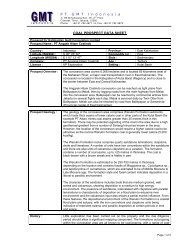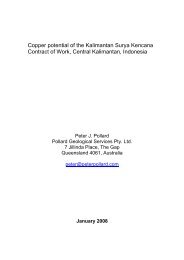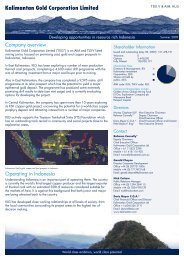Geology and mineralisation of the Mewet Vein, Jelai Gold Project ...
Geology and mineralisation of the Mewet Vein, Jelai Gold Project ...
Geology and mineralisation of the Mewet Vein, Jelai Gold Project ...
You also want an ePaper? Increase the reach of your titles
YUMPU automatically turns print PDFs into web optimized ePapers that Google loves.
PT GMT Indonesia<br />
<strong>Mewet</strong> <strong>Vein</strong> : <strong>Jelai</strong> <strong>Gold</strong> <strong>Project</strong><br />
plagioclase laths, rare fine grained subhedral granular quartz <strong>and</strong> scattered fine to medium<br />
grained opaques. These are hosted within a groundmass <strong>of</strong> broken feldspar, mafic minerals,<br />
minor quartz phenocrysts <strong>and</strong> glass. Irregular compressed cavities are common. Mafic<br />
phenocrysts are pervasively altered to chlorite <strong>and</strong>/or smectite. Plagioclase is commonly<br />
replaced with calcite <strong>and</strong> more rarely by chlorite or smectite.<br />
In close proximity to <strong>the</strong> veins <strong>the</strong> plagioclase displays weak to moderate sericitic alteration <strong>and</strong><br />
occasional replacement by adularia. Vesicles within <strong>the</strong> groundmass are commonly infilled with<br />
calcite <strong>and</strong> in zones <strong>of</strong> strong propylitic alteration also with chlorite <strong>and</strong> epidote. Haematite<br />
staining is a common feature <strong>of</strong> <strong>the</strong> fine grained glassy groundmass.<br />
6.4.2<br />
Andesite Intrusives<br />
Andesite is characterised by a porphyritic texture <strong>of</strong> euhedral or partly resorbed phenocrysts set<br />
in a fine grained, glassy groundmass. The <strong>and</strong>esite generally displays pervasive alteration with<br />
a strongly bleached, pale green colouration. It commonly contains vesicles infilled with quartz<br />
<strong>and</strong> in zones <strong>of</strong> strong propylitic alteration, chlorite, haematite <strong>and</strong> calcite. Irregular patchy<br />
alteration gives rise to a pseudobreccia texture.<br />
6.4.3<br />
Andesitic Basalt<br />
The <strong>and</strong>esitic basalt is characterised by fine to medium grained mafic <strong>and</strong> felsic phenocrysts set<br />
in a fine grained, glassy groundmass. It is essentially unaltered but fine to medium grained<br />
hornblende phenocrysts <strong>of</strong>ten display weak chloritic alteration <strong>and</strong> trace haematite is <strong>of</strong>ten<br />
observed along micr<strong>of</strong>ractures.<br />
6.4.4<br />
Lithic Tuffs<br />
Lithic tuffs occur as rare thin units within <strong>the</strong> <strong>and</strong>esitic volcanic sequence. These units are<br />
typically poorly sorted <strong>and</strong> fine to coarse grained with subangular to well rounded clasts. Clasts<br />
are predominately silty mudstone <strong>of</strong> <strong>the</strong> Menterang Formation <strong>and</strong> meso<strong>the</strong>rmal quartz.<br />
Approximately 30% <strong>of</strong> <strong>the</strong> larger clasts are composed <strong>of</strong> <strong>and</strong>esitic pyroclastics with 90% <strong>of</strong> <strong>the</strong><br />
matrix being composed <strong>of</strong> very fine <strong>and</strong>esitic tuff clasts. Devitrified glass shards are also <strong>of</strong>ten<br />
observed within <strong>the</strong> matrix. The lithic tuffs are pervasively sericite altered. Part <strong>of</strong> this unit may<br />
represent thin intrusive breccias.<br />
6.4.5<br />
Dacite Porphyry<br />
The dacite porphyry occurs as irregular stocks, dykes <strong>and</strong> plugs in <strong>the</strong> area <strong>and</strong> comprises a<br />
grey to green-grey fine grained rock with prominent quartz eyes to 10 mm in diameter. The fine<br />
grained mafic component is occasionally chloritised <strong>and</strong> sericite is also common in some areas.<br />
In some areas, <strong>the</strong> epi<strong>the</strong>rmal vein structures are associated with <strong>the</strong> contact <strong>of</strong> <strong>the</strong> dacite<br />
porphyry, such as <strong>the</strong> Sembawang <strong>Vein</strong> but in o<strong>the</strong>r areas <strong>the</strong> drilling has intersected significant<br />
<strong>mineralisation</strong> without <strong>the</strong> presence <strong>of</strong> <strong>the</strong> dacite porphyry in close proximity <strong>and</strong>, <strong>the</strong>refore,<br />
<strong>the</strong>re appears to be no consistent relationship between dacite porphyry intrusives <strong>and</strong><br />
<strong>mineralisation</strong>, o<strong>the</strong>r than as a host.<br />
6.4.6<br />
Rhyolite<br />
The rhyolite is restricted to <strong>the</strong> east <strong>of</strong> <strong>the</strong> concession area, where <strong>the</strong> rock has intruded into <strong>the</strong><br />
main fault line <strong>of</strong> <strong>the</strong> <strong>Jelai</strong> Fault System as a single stock. The rock is pink-brown, strongly flowb<strong>and</strong>ed<br />
<strong>and</strong> is variably, albeit weakly, altered. Little is known about <strong>the</strong> genetic relationship<br />
between <strong>the</strong> rhyolite <strong>and</strong> <strong>the</strong> o<strong>the</strong>r intrusive <strong>and</strong> it is no known if <strong>the</strong>re is a genetic relationship<br />
to any mineralization style in <strong>the</strong> area.<br />
0065 JCM/GEO/2009.04 Page 19










